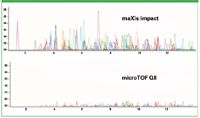Accurate Mass Screening For Pesticide Residue Testing
The update to the SANCO guidelines in 2009 recognized the power and potential of TOF mass spectrometry for pesticide screening applications. When compared with historical screening tools (such as the use of triple-quad mass spectrometry), high performance accurate mass TOF systems offer several advantages for screening applications. These advantages include better resolution, unlimited multiple target capabilities, and the possibility to perform comprehensive and/or retrospective analysis on samples in silico at will.
The update to the SANCO guidelines in 2009 recognized the power and potential of TOF mass spectrometry for pesticide screening applications. When compared with historical screening tools (such as the use of triple-quad mass spectrometry), high performance accurate mass TOF systems offer several advantages for screening applications. These advantages include better resolution, unlimited multiple target capabilities, and the possibility to perform comprehensive and/or retrospective analysis on samples in silico at will.
The maXis impact™ continues the evolution of Bruker's unique TOF accurate mass instruments. The performance of ≥ 40 k resolution, ≤ 1 ppm mass accuracy and high isotopic fidelity is maintained without sensitivity compromise. While acquisition at up to 50 Hz enables maXis impact to handle the fastest of UHPLC separations with ease. Additionally, to aid in quantitative applications, the maXis impact delivers an increase in sensitivity of up to 50 fold over previous generation instruments, especially at the low m/z MS-MS signals important for analyte confirmation.
The dramatic increase in sensitivity changes the game for pesticide screening applications. With LODs typically in the sub ng/mL levels, achieving excellent MRLs becomes very easy. The maXis impact enables analysts to obtain both qualitative and quantitative results in a single analysis. Identification data including accurate mass MS and MS-MS, isotopic pattern fitting and Rt fitting can be readily collected and correlated in dedicated software. In the same run, sub ng/mL LOQs with dynamic ranges over 4 orders of magnitude can also be obtained (Figure 1).

Figure 1: Fluoxastrobin at 50 fg to 1 ng on column.
Taken together, the key qualitative and quantitative performance attributes of the maXis impact make it an excellent choice for routine pesticide screening applications with confirmation and quantitation in a single run. The maXis impact can provide comprehensive data quality that is unmatched by any other technology currently available.
Experimental
A mixture of 200 pesticides was run on the PesticideScreener™ application. This mixture has previously been well characterized and publicized. This same mixture was used to assess the performance of the maXis impact and specifically to assess the increase in sensitivity observed.
Conclusions
The maXis impact changes the game in small molecule pesticide screening. Sensitivity increases of 20 to 50 fold versus previous systems are routine. This enhanced sensitivity, coupled with the additional capabilities of the maXis impact, allow both high quality qualitative and quantitative data to be acquired in a single run (Figure 1). The capabilities of the maXis impact are ideally suited to pesticide screening and quantification, and provide an unrivalled level of confidence at sub ppb levels.
To further optimize the use of the maXis impact for pesticide screening, the PesticideScreener application platform is a fully developed protocol, allowing the use of accurate mass and isotopic pattern fitting and retention time fitting, for straight-out-of-the-box implementation of this outstanding analytical system (Figure 2).

Figure 2: Overlapped hrEIC traces showing the evolution of TOF sensitivity.
The maXis impact sets the new gold standard for pesticide screening through full utilization of the capabilities of ultra-high-sensitivity TOF accurate mass spectrometry.
Bruker Daltonics Inc.
Billerica, MA
tel. (978) 663-3660, fax (978) 667-5993
Website: www.bruker.com/maXis

Separation of Ultra-Short and Long Chain PFAS Compounds Using a Positive Charge Surface Column
December 11th 2024A separation of ultra-short and long chain PFAS (C1-C18) is performed on a HALO®PCS Phenyl-Hexyl column along with a HALO®PFAS Delay column which demonstrates excellent retention for both hydrophilic and hydrophobic analytes.















